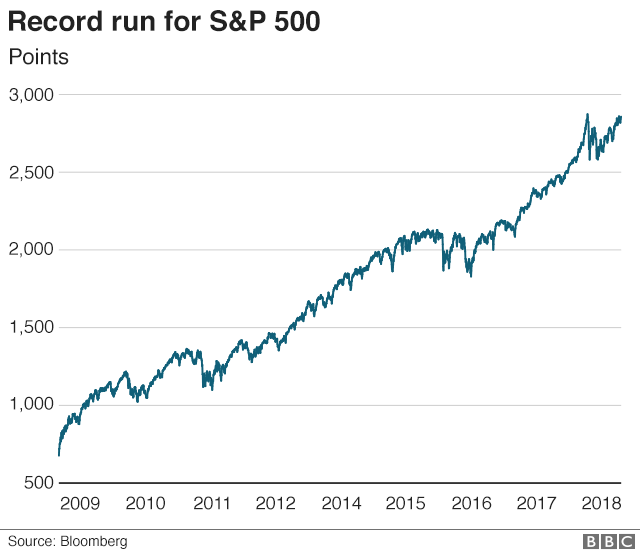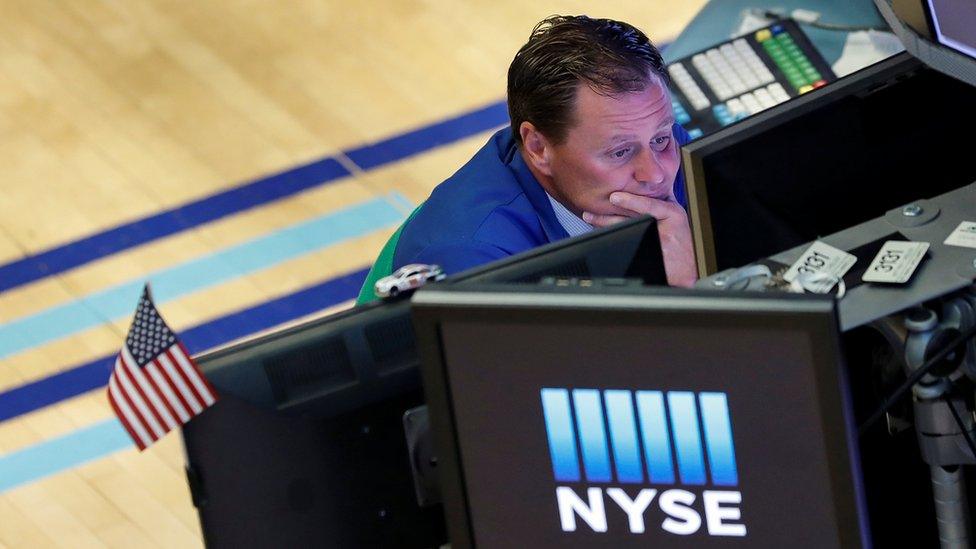Will the US stock market boom continue?
- Published

Should we celebrate the recent market milestone?
America's benchmark stock index, the S&P 500, hit a major milestone this week, marking nearly nine and a half years of gains and closing at a new high.
By many counts, it was the longest period without a 20% or more drop in index history, surpassing the previous record set in the 1990s.
US President Donald Trump and others celebrated the lengthy rally, known as a bull market in Wall Street jargon.
Should we all break out the champagne?
Does it reflect real economic strength?
The US and global economies have come a long way over the last nine years.
But the rise in the US outstrips global market performance - and many economic indicators in the US.
The S&P index, the broadest measure of the US stock market, has increased more than 300% since 9 March 2009, when it hit a low in the aftermath of the financial crisis.

In that same period, US economic output has increased by about 40%, while wages are up just 23%, not adjusting for inflation.
Meanwhile, median household wealth in the US - which factors in assets such as homes - has actually declined, falling by more than 30% between 2007 and 2016, if you adjust for inflation.
That's a reminder that many families have not benefited from the stock market gains.
About 55% of US families have money in the market, whether directly or through retirement accounts, according to a Gallup poll in April.
But the richest 10% of households own about 84% of shares, according to a 2017 study by New York University Professor Edward Wolff, external.
Outside the US, estimates of household stock market participation are even lower.
So what is behind the bull market?
There are still a lot of reasons for shares to have done well.
Factors such as low inflation, lacklustre wage growth and last year's corporate tax cut have boosted company profits.
US wages appear stuck, despite Trump's claims of a roaring economy
Interest rates, which central banks cut during the financial crisis, remain low by historic standards, which has kept stocks attractive to investors.
The growth of the technology sector - think of companies such as Apple and Microsoft - has also played a role.
Technology firms accounted for more than 20% of the bull market gains, according to analysis by Howard Silverblatt, senior index analyst for the S&P Dow Jones Indices.
Public companies - especially a subset of "supersize" firms - have also accrued greater market power, especially in the US, contributing to corporate profits, according to IMF analysis, external.
And companies are directing more of those gains to shareholders in the form of stock buybacks, which tend to boost share prices.
Between 2007 and 2016, companies in the S&P 500 spent 54% of their profits on buybacks - more than double the share in the 1980s, according to analysis by William Lazonick, a professor at the University of Massachusetts, Lowell, external.
OK, so is the rally here to stay?
In the short-term - say roughly the next 12 months or so - most analysts expect the market to rise, at least modestly.
But the investment climate has shifted a bit since last year's blockbuster gains.

Some global markets have declined this year
In the US, the S&P 500 has increased more than 6% so far this year, closing at a record 2,874.76 on Friday.
The Dow has risen about 4%, while the tech-heavy Nasdaq is up more than 13%.
Elsewhere, stock markets have slumped, as economic data weakens and risks grow.
The Global Dow is off about 1% so far this year, while the Nikkei 225 has slumped about 4%.
In China, the Shanghai Composite has tumbled about 18%, while the Hang Seng in Hong Kong is down about 8%.
In Europe, Germany's Dax index is down almost 4%, while the FTSE 100 in the UK has fallen about 1%.
What are the risks?
The UK and the European Union remain locked in negotiations over Brexit, which has torn an economic relationship built over decades.
Growth is slowing in China, an issue exacerbated by a widening trade fight with the US.
Even in America, economic data has been mixed.

Analysts say the US-China trade dispute risks hurting global growth
Job creation has been strong and unemployment remains near record lows, but some metrics watched closely by economists, such as housing starts and home sales, have slipped.
Inflation and wage costs have also showed signs of an uptick, which could eat at corporate profits and have pushed the Federal Reserve to raise interest rates.
The rising rates have already played a role in strengthening the US dollar, which has hurt US exporters and intensified financial woes in emerging markets with high levels of debt in dollars.
Higher rates also threaten to make stocks less attractive and dampen economic activity.
Meanwhile, forecasters are trying to figure out the fallout from White House trade fights, including tariffs that have raised the cost of raw materials such as steel and aluminium and led to retaliation against US exporters including farmers.
All of this means many people will be watching the market closely in coming months.
- Published21 August 2018

- Published27 July 2018

- Published16 July 2018
